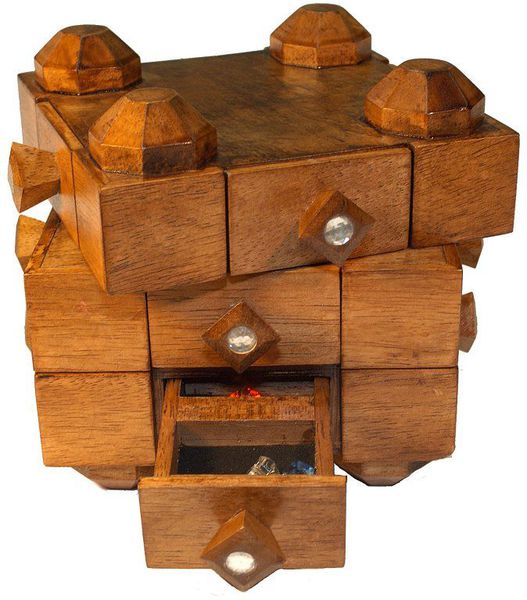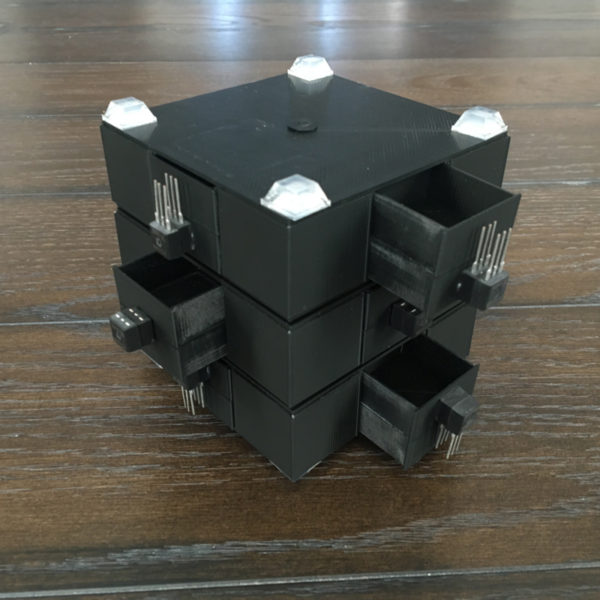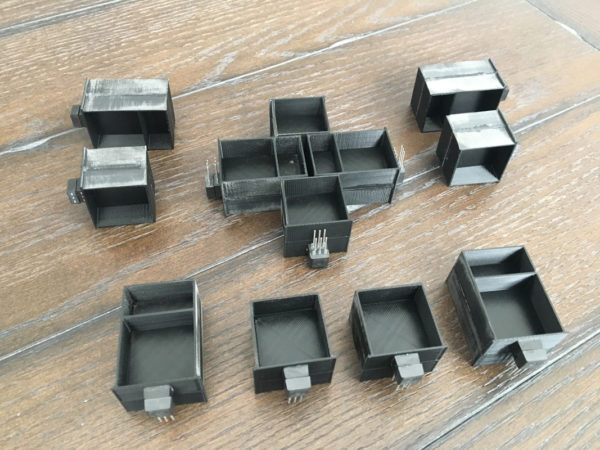For a few years now (or actually closer to a decade), my group and I have wondered about a curious deduction game called Master Thieves. This game centers around a wooden jewelry box contraption that the players manipulate to gain resources and win the game. We first encountered the game at BGG Con long ago but never tried it. With a $170 price tag on the secondary market and the game out of print, buying the game outright is a huge risk. Luckily, we have the technology to rebuild him. or her. it?

This rather silly 3D print of the game box didn’t take long to CAD up in Fusion360. After thinking about the engineering for a little bit, the 3D modelling came together quickly and Reese was able to print up the pieces over the course of a week.

The original wood design shows the concept pretty well. Three square levels with drawers on each side. Each drawer has a container compartment on both the top and bottom so the entire piece can be flipped upside down and the contents of the drawer can be in either side. Each level also spins along a central axis.

After a little bit of testing, we found the appropriate drawer size and sanded them smooth to make sure the drawers could slide easily.

I did not have confidence in the structural integrity of a single central rod to allow for the independent levels to rotate so I made short rods per level. This allowed each level to glue into the next and also have stability within the middle section of each flat part of the base. My concern was that a central rod, tightened to the top and bottom of the overall structure, would bow the outer top and bottom and potentially compromise things. Regardless, the system I made works for the prototype and will be the way I move forward if I need to print it again.

Each of the rods have a flat nail head for a base with a hole that the next rod can sleeve into. The original design was 4x the size of this one but in the interest of time and material use, Reese smartly reduce it all down by 50%. This did make the rods a little fragile as the walls were now a lot thinner. The rods were quick and easy to print so after destroying a couple, I found the right technique to assemble the pieces without trouble.

The drawers could have been printed as a single piece but the flat “roof” of the lower drawer would have required a lot of scaffolding and it seemed easier to just make the half drawer and print it twice. After printing, I glued the two halves together and sanded down any excess super glue.

There are actually two drawer types. The standard square drawer and then the long drawers with a “secret” compartment. The four drawers fit inside the level in the configuration above.

My biggest regret was not thinking of drawer pulls. I thought that I could just attach something but in hindsight, I would have liked to design something that matched the minimalist design that the box took on. Reese had a bunch spare computer components so I chose a bunch that created some semblance of a design and superglued them on. We tried out the game and I originally had just one component on each drawer but they weren’t big enough and it was hard to get a hold of some drawers so I added a second. When/if I make version 2.0, I’ll add my own drawer pull design.

While the box itself was the biggest hurdle to getting the game to the table, there were still all the other components to make it a full game. Luckily, these are really easy as I do this kind of work all the time when prototyping playtest material for publishers.
I was never a fan of the art, or honestly, the aesthetic of the original wooden box so when I created my own, I decided the black box and tech theme I was going for need to retheme the whole game. I chose a cyberpunk theme, ripped off the fantastic art from Netrunner, and made new cards.

After investing all this time into the game, I didn’t want to put anymore effort into the retheme until I had a chance to play the game. If the game met the approval of the group, I will continue forward but at this point I just wanted to get the game to the table.
I bought a pack of little glass tiles to substitute for the jewels of the original game and grabbed a few containers for the “pillows” (a sort of scoring tracker in the original game).

I needed one last component to cover the “alarm” tokens so I grabbed a few more components and used some used up Ti chips. We were now ready to play. I made enough components for five players but the game originally can handle eight.
I got the game to the table this weekend and had five of us try it out. Verdict? ummmm. Meh.
Well, that is harsh. It wasn’t that bad and I think everyone would play it again but it wasn’t an amazing experience that everyone was clamoring to try again. I think a big issue was expectation. We all had different ideas as to what the game is about and what the experience would be like but the game proved to be quite different.
The game is a deduction game where you are trying to keep track of where the tiles are in the box as players rotate and flip the game around. I found this pretty difficult as did a few of the other players but I think it was because I was trying to do too many things at once. I was trying to make sure the rules were understood, which I had made difficult by retheming the cards but not the rulebook itself. Also, I was trying to pay attention to how the box was working itself and what I might need to improve it. One or two drawers were so loose that when players flipped the box, it would fall out and the contents would go all over the table. This meant everyone now knew the contents of that box and messed up the game’s deduction mechanic.
Ultimately, I think I need to play the game a bit more to get into it. To do that, I need to improve the box a little more to make it more user friendly. The extra drawer pulls will help and initially I thought magnets would work to hold in the drawers but I found that I won’t be able to put them in without destroying the box itself. Boardgamegeek user, Dale Braun, had made a wood version and said he put wax on the drawer sides so I might try that to see if it keeps in the loose drawer without resorting to new fixes.
To complete things, I will finish making the rest of the components to match my theme and complete the project but I’m glad I did not try to spend that much on the game itself. I enjoyed the creation of the project so I’m not disappointed at all in the experience either so I’d call it all a solid win.
